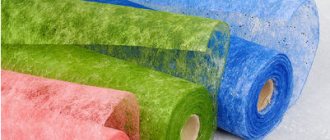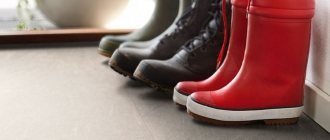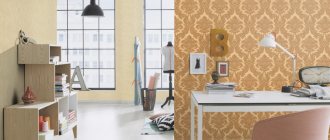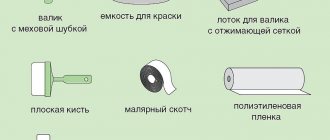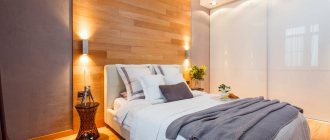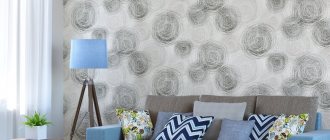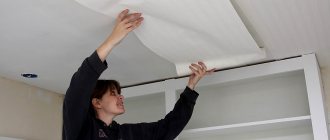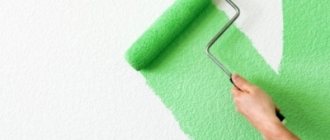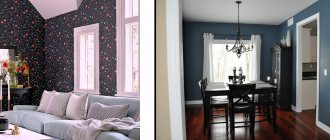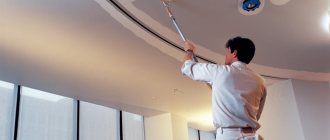Paintable wallpaper is one of the popular options for wall decoration, allowing you to create a unique interior in any room. The coating has an affordable price and a wide range of colors. Wallpaper is easy to glue and easy to care for, so it is not surprising that its popularity is increasing every year.
The choice of wallpaper paint for painting is influenced by the following:
- type of wallpaper;
- size of living or office space;
- lighting level in the room;
- operating conditions of the premises;
- the amount allocated for the purchase.
If the paint is of high quality, it is applied to the surface evenly, in a thin layer. It does not form stains or smudges. Unscrupulous sellers dilute it with water, which negatively affects the quality of the wallpaper and coating, so you should only buy paint from trusted suppliers.
Types of paints for different types of wallpaper
The industry produces the following types of paint:
- acrylic;
- latex;
- water-based.
Acrylic paint is deservedly popular among consumers. Its advantages include high coating strength and moisture resistance. The composition does not contain harmful chemicals that could be released during the application process, so there is no strong odor when painting.
This paint can be used to cover any wallpaper; you should only be careful with paper ones, as this type of canvas becomes heavier after painting. The walls take a day to dry.
Wallpaper coated with acrylic paint can be washed. It is allowed to be used in any type of premises, even with high humidity levels. Due to the fact that after drying a film does not appear, the walls “breathe” and mold does not appear on them.
If your budget is limited, water-based paint is a good choice. Given its low cost, it is often used for interior finishing work. It is applied not only to the ceiling, decorative plaster, but also to wallpaper.
When choosing paint, you should take into account that it is not durable and easily comes off the surface. It is enough to rub a damp cloth over it so that the color begins to wash off.
The surface painted with water-based paint must be protected from direct sunlight, since such a coating is susceptible to fading. You need to choose a shade taking into account the fact that after drying it will become a little lighter.
Latex paint is one of the most expensive and high-quality paints on the market. It contains no harmful substances, it dries quickly, forming a breathable coating. It has a special silky texture, which allows it to be used in any living space.
Apply a thin layer of latex paint to wallpaper, but it is difficult to achieve a rich, bright color. It is designed for painting surfaces in soft shades. To prevent the appearance of defects during application (smudges and noticeable transitions), it is necessary to work carefully and quickly.
When purchasing latex paint, you should pay attention to the gloss. The higher its degree, the stronger the paint adheres to the surface.
Selection rules
How to choose wallpaper paint for painting depends on the quality of the base on the walls, the percentage of humidity in the room and, of course, the budget for repairs. Let's consider all types of coloring compositions that are used to give a new shade to wallpaper.
Acrylic paint
Acrylic paint for wallpaper for painting is a water-based material. The richest palette of wallpaper paints belongs to acrylic compositions. The binder in them is acrylic resin.
It is different:
- moisture resistance;
- allows air to pass through, which is why it is called “breathable”;
- has a huge number of shades - you can choose for every taste;
- not exposed to sunlight;
- remains on the wall for a long time and does not change its color for years.
High-quality expensive compositions are very economical, because one layer is enough to paint over the previous shade .
Acrylic paint for wallpaper dries quickly and is odorless. It does not release harmful chemicals into the environment, therefore it is successfully used in the interior of children's rooms.
There are nuances when using different types of foundation:
- Suitable for paper webs.
- For vinyl wallpaper, acrylic paint must have a latex base - this is mandatory.
- Acrylic trellises can be safely painted with acrylic compounds.
- Acrylic is a good paint for non-woven wallpaper.
Important! You can paint wallpaper with acrylic up to 15 times, which saves time and budget.
Water-based paint
Water-based painting materials include silicate, silicone, and mineral compositions.
The most expensive are silicone paints. They are able to prevent the appearance of mold on the walls and are resistant to moisture. Silicate compositions are made on the basis of silicate glue and pigments . They last a long time and are resistant to weather conditions.
Mineral ones contain cement and lime. They have a disadvantage - a short service life.
When painting wallpaper with water-based paint, pigment is added to it - color. It is important to immediately calculate the quantity correctly, or better yet, with a reserve, because if there is not enough composition, it will be difficult to achieve a complete color match.
Attention! Any type of wall covering, except liquid wallpaper, which has its own coloring agent, can be coated with water-based emulsion. You should expect two layers of coverage.
Latex paint
Creates a thin film of polymer material due to fine particles, which stick together when water evaporates and create a durable coating that:
- long-term use;
- easy to clean from dust and dirt;
- does not suffer from humidity.
Latex compounds dry quickly - only 2-3 hours.
They have a large selection of colors and shades. Latex wallpaper paint for painting is suitable for all types of coating. Liquids are not considered, since they are not suitable for additional coloring. When painting the base with latex compounds, it is not recommended to cover the wall with a classic primer , as this prevents the paint from being absorbed. It will be difficult to distribute evenly over the surface. The first layer is applied diluted, the second - normal.
If you take breaks in work, the joints will be noticeable, so the entire wall needs to be painted at once. The roller should not be made of foam rubber, as it creates air bubbles that burst when dry. If drips occur, they should be removed immediately before they dry.
Polyvinyl acetate paints have one significant advantage - they are cheap, since they are an aqueous solution of PVA glue with the addition of pigment. The downside is that such materials do not adhere firmly to the base and can get dirty if touched. Also, PVA paints deteriorate from the cold. It is advisable to use them in warm living spaces in places that are out of reach - behind furniture, in a closet.
Styrene butadiene compounds are a type of latex paint. They are more resistant to smudging, but are more susceptible to sunlight. Ideal for painting corridors where their service life will be maximum.
Alkyd paints are sensitive to moisture, but are well suited for dry rooms. Inexpensive. Can be cleaned with detergents. But there is one significant drawback - the alkyd film does not breathe, so condensation may appear . Well suited for fiberglass and fiberglass wallpaper.
Tikkurila paint
The well-known Tikkurila brand is represented by various paint and varnish materials, including those for painting wallpaper. Has positive characteristics:
- easy to clean with conventional means;
- has increased abrasion resistance and is not afraid of numerous cleanings;
- completely safe for health, which is confirmed by environmental certificates;
- has no smell;
- economical - one full layer of coating is enough , and the previous color will not show through the new one;
- easy to apply.
It is allowed to paint wallpaper in medical institutions.
It is better to choose painting materials based on the type of base:
- For paper wallpaper it is better to use latex. Thin film does not create additional stress on thin paper. Can be repainted several times.
- It is better to paint the non-woven base with acrylic or latex.
- The vinyl base is more similar to acrylic. But if vinyl trellises have a non-woven base, then latex is also used.
- The fiberglass base accepts all types of paints, just like paper ones. But fiberglass can be painted up to 10 times.
You need to start covering the wallpaper no earlier than 2-3 days after gluing, so that the wallpaper glue is completely dry.
Which paint is better: acrylic, water-based or latex?
The choice of paint depends on the buyer’s preferences, the amount allocated for the purchase and the type of wallpaper. Before purchasing, you should compare the advantages and disadvantages of paint and varnish products.
Acrylic paint has an affordable price, the texture is only matte. The advantages include the following:
- resistance to mechanical damage and moisture;
- wide range of shades;
- easy application without smudges;
- resistance to fading under the rays of the sun;
- no smell.
Water-based is afraid of moisture and direct sunlight, but it has the following advantages:
- dries quickly and has no odor;
- easy to apply to the surface;
- lie down straight;
- texture matte and glossy.
The paint is initially white, but thanks to tinting you can achieve any shade.
Latex is expensive, but thanks to it you can create a luxurious coating. There is a slight odor when painting.
If the budget is not limited, you should give preference to latex paint. For utility rooms or inexpensive repairs, a water-based one is suitable, but in other cases it is worth using acrylic.
Water-dispersion paints
The most popular and frequently used paints are water-dispersion. They have a relatively environmentally friendly composition, since they do not contain resins, various oils and other harmful components, and a wide palette of paint colors allows you to choose the desired shade without much difficulty. Thanks to this, it is possible to use paint for interior wall decoration.
In turn, latex paint is produced on acrylic and non-acrylic bases, which has certain differences. The first option is mainly applicable for painting non-woven wallpaper with different textures and fiberglass.
It dries quickly, has a subtle odor, but is definitely not suitable for rooms with high humidity, for example, a bathroom, toilet, loggia.
The second option is achieved with acrylic latex and butadiene sterol in the composition, which makes the paint elastic and very durable.
The disadvantage may be the color palette, because the paint sold is mainly white, but if necessary, you can add a special color, but you won’t be able to achieve a bright shade, so the color palette is extremely soft and calm.
Painting technology
If the surface area is small, paint and varnish materials are applied with a brush and roller. A brush is needed for painting hard-to-reach places, and a roller is used on smooth areas.
A single-layer coating does not provide high-quality painting, so after the first layer has dried, the paint must be reapplied. When painting large areas and hard-to-reach places, it is convenient to use a spray bottle. An electric device is easier to operate and cheaper than a pneumatic one.
The procedure for painting wallpaper for painting consists of several stages:
- The paint is applied only to dry wallpaper, so you need to wait until the glue has completely dried.
- Areas that do not need to be painted are isolated with masking tape. First, paint hard-to-reach places, as well as those covered with tape. Then paint is poured into the tray and the roller is dipped. It is best to use a tool with long bristles, this will allow you to carefully paint over the textured details of the design.
- The wallpaper in the room is painted, moving from window to door, with a roller drawn along the wall from top to bottom.
Colored stripes or designs are often applied to wallpaper; stencils are used for this purpose. Paint over an already applied layer of paint.
It is possible to fix the paint with varnish; this finishing coating protects the wallpaper from mechanical damage.
How to paint wallpaper yourself
Wallpaper painting tools:
- velor (sheepskin) roller, telescopic handle and paint tray;
- small brush for narrow areas;
- film for covering floors, window sills, radiators;
- masking tape for local protection of surfaces;
- a rag for wiping up splashes.
Instead of a roller, you can use a spray bottle.
Wallpaper painting technology
Remove household appliances and furniture from the room. Cover all surfaces with plastic wrap and seal the baseboards with masking tape. Putty the walls along the cracks and treat them with a primer to ensure strong and durable adhesion of the wallpaper to the surface of the walls. Start finishing approximately 3 days after gluing the wallpaper.
Stages of work:
- Prepare your tools. Clean the roller of lint by running it along the sticky side of the masking tape.
- Prepare the paint according to the manufacturer's instructions and pour it into the tray.
- Before the main painting, do a test on a small section of the wall.
- Use a brush to paint corners and other narrow areas.
- Dampen the roller with paint and cover the walls in two layers. For ease of operation, use the telescopic handle.
Features of wallpaper painting
If you study sales statistics, the most popular wallpaper for painting is non-woven wallpaper. They are moisture-resistant, so they are used for covering walls in corridors, hallways and other rooms where there is a high probability of surface contamination.
Latex paint works best with non-woven wallpaper. Walls covered with it can be washed, using cleaning products to remove dirt. The paint is applied using a roller with long pile. To thoroughly paint the design, apply at least 2 layers.
Glass wallpaper is considered the most durable; it can be repainted up to 30 times. Any paint works well on them; it penetrates deeply into the fibers. Before starting work, a primer is applied to the wallpaper. When it dries, paint the walls; in total you will need to apply 2 layers of paint and varnish material.
Fiberglass wallpaper absorbs paint well, so its consumption will be higher than when painting walls covered with paper wallpaper. When working with glass wallpaper, personal protective measures should not be neglected.
Vinyl wallpaper is first primed. If they are made on a paper basis, then they should not be heavily impregnated with paint and varnish material. For products with a weakly expressed pattern, 1 coat of paint is sufficient.
Paper wallpaper is painted with water-based paint. It is applied in 1 layer, and then the areas that remain untinted are painted over.
What paint is best to paint wallpaper?
There are many manufacturers and brands on the market that produce wallpaper paint for painting. Which colors to choose – that is the question. One of the most popular companies that does this is Tikurilla. Among the advantages of the paint from this manufacturer - Tikkurila, it should be noted that it is easy to apply, a wide range, high durability, and no need for sanding.
Most people paint with this paint. Also, the products of the Russian company Tex are very popular.
Many say that thanks to the products of this particular brand they were able to transform their apartment beyond recognition for a long time. Reviews confirm that the paint dries quickly, which is a significant advantage. In addition, they notice that there is practically no smell, the surface after painting is ideal, matte, beautiful.
Painted wallpaper in the interior
Painting walls is one of the fashion trends of recent years. Professional interior designers prefer this finishing option. In order for the paint to adhere perfectly, the wall surface must be free of flaws, so you cannot do without a professional approach to such finishing.
Those people who do repairs on their own may not putty the walls, but cover them with wallpaper. This will allow you to hide all the unevenness of the walls.
On sale you can see non-woven, vinyl and other paintable wallpapers. They will transform the interior and make it modern.
Tools
When the base is glued and it’s time to paint, you need to prepare the following tools and equipment:
- the actual paint, mixed with the coloring manually or using a computer method in a construction supermarket;
- roller - preferably made from synthetic materials that do not leave marks or lint on the walls and distribute the substance evenly;
- paint tray;
- special tape for gluing skirting boards and cornices;
- medium size brush for painting walls under eaves and above skirting boards.
You should not skimp on tools, since the appearance of the wall also depends on their quality.
Coverage options
Wallpaper paint for painting allows you to achieve different effects when decorating walls. It all depends on what paint material was used. The following options are available:
- For small rooms, northern rooms, glossy paint is suitable. Since it highlights surface defects, the walls are leveled before wallpapering.
- Semi-gloss is suitable for painting any room, but the walls must also be smooth.
- Mother-of-pearl changes shade when the angle of incidence of light changes. In rooms where the wallpaper was painted with this paint, it is worth using diffused lighting, this will allow you to achieve a better visual effect.
- The shimmering effect can be easily achieved by painting the wallpaper with pearlescent paint. The beauty of surfaces is emphasized by sconces and floor lamps.
- Semi-matte paint is suitable for the bedroom; it is used for painting walls in a small living room and kitchen.
- Matte paint absorbs light, so it is the best option for painting walls in spacious rooms.
When choosing paint and varnish materials, you should take into account the functional purpose of the room, its location relative to the cardinal points and its area.
The right approach
When the wallpaper has already been hung, wallpaper paint for painting has been selected and purchased, you can proceed directly to the artistic process.
If the wallpaper has been hung recently and there is no dust or dirt on it, then it does not need to be primed.
Tools and materials we will need:
- brush;
- roller - the length of the pile depends on the paint used (the best option is medium pile);
- portion tray;
- masking tape;
- floor covering (film, oilcloth);
- directly the paint itself.
Stages of work:
- Painting tape is applied around the perimeter of the surface to be painted, where it comes into contact with the ceiling and floor.
- Covering material is spread on the floor (if paint drips).
- The composition for coloring is prepared - diluted if necessary, poured into the tray.
When rolling out the roller, the paint should evenly saturate its entire surface, but there should not be any excess; to do this, the roller should be passed along the ribbed surface of the tray.
- The roller is rolled along the wall several times with the same pressure and in the same direction.
- Corners and places next to masking tape are painted with a brush.
- The entire surface to be painted must be treated in one step.
Remember: applying paint for wallpaper occurs only after the surface to be treated has completely dried; ideally, two days should pass after wallpapering.
Manufacturers
The durability of the coating depends on the quality of the paint, so it is better to choose products from reliable manufacturers. In the budget segment, the following paint and varnish materials have a high rating:
- Marshall (Türkiye) offers Maestro Acomix. Wallpaper to be painted can be wiped with a damp cloth, but direct contact with water should be avoided. Suitable for rooms where there is a high risk of wall contamination.
- Tikkurila (Finland) produces Finncolor. The coating is wear-resistant. The paint protects walls from mold, so it can be used in rooms with high levels of humidity.
In the middle price segment, buyers have the following options:
- Belinka. Thanks to tinting, you can get any shade. The paint is thick and easy to apply. Painted wallpaper can be washed.
- Caparol produces Alpina paints. They are durable and do not fade. Paintable wallpaper coated with this paint can be washed.
In the premium segment, products are offered by Dulux and Beckers. The paint undergoes multi-stage control, it is safe, and has quality certificates. The color is deep, a wide selection of tones will allow you to choose the covering for any room.
Stages of work
When the wallpaper paste has completely dried, you can begin applying the coloring material to the walls.
To do this, you need to pour a certain amount into the tray and soak the roller well. First, seal the area under the ceiling with masking tape. Next, use a brush to paint the area under the tape to make it look neater. The next point is the corners, which are also painted with a brush.
Next, you need to put a stepladder and start applying the painting composition to the upper part of the wall, so as not to accidentally smear what has already been painted. It is better to treat the entire wall at once so that there are no visible joints. This is done with a roller - it will do the job faster.
Based on our experience of using various types of wallpaper paints for painting, we can give some useful tips to beginners:
- It is better to tint the base using the computer method . If there is a shortage of a substance, there is a chance to choose a similar color. Manually achieving a complete match is almost impossible.
- The paint consumption for wallpaper for painting depends on the quality of the material. The more expensive, the less volume needed.
- The color should be chosen lighter than on product samples. As it dries, the shade becomes darker .
- It is better to cover walls that are exposed to sunlight with acrylic compounds - they are more durable and do not fade.
Advice! If you are planning a renovation for the first time and have no previous experience in carrying out construction work, you need to carefully study how to choose paint for wallpaper for painting on forums where people exchange knowledge for free.
Choice of colors
The paint color is chosen based on the wishes of the buyer, the characteristics of the room and the amount allocated for repairs. If previously manufacturers produced white paint, to which they then added the desired pigment, thanks to computer tinting, everything has changed.
Now the program does the calculations, determining the amount of pigment needed to obtain a shade of color.
There is a myth that small rooms should only be painted in light shades. But thanks to the competent combination of different colors and textures, you can “play” with any space and highlight separate zones.
Follow the link: Color catalogs for tinting
We do not tint: Metallic (except Ral 9006 and 9007), Two-component, epoxy and polyurethane paints, Pearlescent and fluorescent RALs
Tinting of paints and varnishes is carried out on professional modern imported high-precision equipment, which guarantees 100% color matching, it allows you to tint cans with volumes from 1 liter to 40 kg (we can tint up to 2 tons per day), while the client receives the finished color for very little money.
Machine tinting of paint allows us to tint water-based paints (latex and acrylic) and oil-based (PF-115 and alkyd), interior paints (for walls and wallpaper) and facade paints (for concrete and wooden houses), impregnations, antiseptics, stains, ready-made plasters , textured paints, rubber paints, metal paints.
Come with samples of the color you need and we will select the color in your presence, we have all catalogs in stock, and you will be able to see your color “live”, whatever the color: gray, brown, yellow, ivory or whatever.
To find out how much it costs to tint a specific color, you can call us by phone, write to us by email or chat with the manager through the Online Consultant. You can also ask your questions in “Help”.
Attention!
The cost of tinting is calculated separately; it is not included in the price of paint and varnish products. Computer tinting is carried out only after prepayment! Therefore, carefully choose the color you need, we are not responsible for your wrong choice!
The most modern way to add color to paints and varnishes today is computer tinting. With its help, you can easily choose any color scheme for individual design of both the facade of the building and the interior of the room. Paints intended for tinting are always white, which is what distinguishes them from other paints that are sold in ready-made color schemes. They are produced in various bases, which differ from each other in the degree of whiteness. If you plan to tint the paint in a dark tone, then we use a more transparent base, and this affects the cost of tinting, reducing it. Very white paints are suitable for tinting in delicate and bright colors when you want to show the fullness and richness of the color. The advantages of computer tinting over manual tinting are obvious.
This:
- Absolute compliance with the color selected from the catalog.
- If necessary, you can reproduce exactly the same color as many times as you like.
- It takes very little time to tint the paint.
- The properties of the paint remain unchanged.
How to calculate consumption?
The consumption of paints and varnishes is influenced by the condition of the surface. Please note that the consumption indicated by the manufacturer on the paint container or on the official website will correspond to that declared only on a smooth, even, cleaned and primed surface.
Poor preparation of the surface to be painted increases paint consumption, requiring more layers to be applied. This is the case when the stingy pays twice.
It’s easy to calculate the amount of paint yourself. It is necessary to measure the length and width of the surface to calculate the area in square meters, then multiply the calculated value by the consumption indicated by the manufacturer.
It is convenient to use the calculators built into manufacturers’ websites; the required quantity of paints and varnishes will be determined by the program automatically after the buyer enters the initial data in special windows.
What colors can you paint on wallpaper?
You need to choose wallpaper paint for painting not only based on color and price. It is necessary to take into account the characteristics of the paint, whether it suits the type of wallpaper, so that the repair is successful and the result is pleasing to the eye. You should not buy water-soluble PVA-based paint. The only advantage of this paint is that it is inexpensive. Other properties include the fact that it is not moisture resistant at all, but on the contrary. In addition, the color palette of this paint is quite poor. What to do if children draw on the wallpaper, and parents want to leave the room beautiful, but at the same time give the kids the opportunity to draw?
How long does it take to dry?
Paint applied to wallpaper dries from 2 to 14 hours. The exact time is indicated on the container and in the instructions. If in doubt, wait 12 hours before applying a second coat.
Paint on porous surfaces and textured wallpaper takes longer to dry. Many people, wanting to speed up the drying process, create a draft or increase the temperature in the room. This should not be done. At high temperatures, the coloring composition liquefies, this negatively affects the properties of the paint.
Drafts are contraindicated, but air must enter the room, so the ventilation must be open.
Paint color palette for wallpaper
When choosing paint, you need to consider what color it is and whether there are patterns on the wallpaper that need to be painted. It's easiest to paint plain white wallpaper, but paintable wallpaper that has designs on it is a little more difficult. Quite often, ready-made paint shades are not suitable for the client. In this case, a coloring pigment is simply added to the white wallpaper paint. Pigment is added to the white paint and everything is constantly mixed. When doing this procedure manually, you need to remember that after drying the shade may differ from what was intended.
It is recommended to aim for a lighter color, apply the paint to a small area, wait for it to dry and see what exactly needs to be changed in the composition of the paint, or make sure that the color meets the requirements and get to work.
But there is a drawback here, since there may not be enough paint, and in this case it is almost impossible to repeat the shade that was obtained before. To select colors, computer technology is often used, with which you can calculate the amount of pigment needed, extract the same color for painting a large room, diluting it in different tanks. This is called computer tinting. With this method, you can simply order a shade and have a computer calculate how much pigment you need to add to get the desired tone. Experts believe that it is best to buy paint in a store along with wallpaper to match the colors. It all depends on how a person sees his room in the future. The color range is quite large, the range is constantly increasing, so any plan can be implemented.
Selection of dyes
Wallpaper paint for painting is chosen taking into account the characteristics of the room. Lighting level, area and number of people passing through the room are the main parameters.
Paint and varnish materials produced by large companies that have been on the market for many years comply with safety standards. When purchasing paint from small companies, you must require certificates.
Paper trellises
Paper trellises are capable of absorbing moisture, which is why they begin to get wet. To prevent this, apply a primer first. Wallpaper is painted with acrylic or water-based paint.
Non-woven fabrics
Non-woven wallpaper for painting is heavy, so special glue is used to fix it. The canvas can be smooth or with a relief pattern; it is a good alternative to fiberglass. Latex or acrylic paint is applied to non-woven wallpaper before painting.
Vinyl reliefs
The top layer of such canvases is made of polyvinyl chloride. Wallpaper has a long service life; it will last more than 10 years. They additionally insulate the room. Acrylic compounds are used for painting; the walls can be washed.
Non-woven
For non-woven wallpaper, you can use various compositions for painting, but acrylic or latex paint is best suited. To work with them, it is better to choose a brush that has hard bristles, so the work surface will be painted with better quality.
There is a rather unusual technique for painting such wallpaper: applying paint to the inside before gluing. Do you want to get an interesting color shade and highlight the structure of the non-woven fabric? Then this method is for you. But remember - only acrylic composition is suitable for these purposes.
USEFUL INFORMATION: Which wallpaper to choose for the kitchen?
Rating of the best wallpaper colors
| Photo | Name | Rating | Price | |||
| Acrylic compounds | ||||||
| #1 | "VD-AK-1180" from Neolab | ⭐ 99 / 100 1 - voice | Find out the price | |||
| #2 | "Cinderella" by ESKARO | ⭐ 98 / 100 | Find out the price | |||
| #3 | "Profi" from "TEX" | ⭐ 97 / 100 1 - voice | Find out the price | |||
| #4 | "W110" by Parade | ⭐ 96 / 100 | Find out the price | |||
| #5 | "Dulux Classic Colour" from AkzoNobel | ⭐ 95 / 100 | Find out the price | |||
| Water-based compositions | ||||||
| #1 | "Vinyl Silk" by Johnstones | ⭐ 99 / 100 2 - votes | Find out the price | |||
| #2 | "Dyopa" by DYO | ⭐ 98 / 100 1 - voice | Find out the price | |||
| #3 | "Dulux Easy" from AkzoNobel | ⭐ 97 / 100 2 - votes | Find out the price | |||
| Latex compounds | ||||||
| #1 | "Beta Interior Paint" from OLIMP | ⭐ 99 / 100 | Find out the price | |||
| #2 | Latex paint from "LAKRA" | ⭐ 98 / 100 | Find out the price | |||
| #3 | "Dulux 3D White" from AkzoNobel | ⭐ 97 / 100 1 - voice | Find out the price | |||
| #4 | "Retail Eurolatex 7" from Dufa | ⭐ 96 / 100 | Find out the price | |||
| #5 | "Samtex 7" from Caparol | ⭐ 95 / 100 1 - voice | Find out the price | |||
What wallpaper paint would you choose or recommend?
Take the survey
